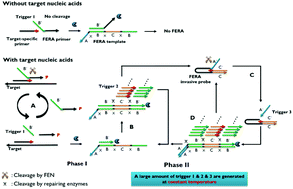Flap endonuclease-initiated enzymatic repairing amplification for ultrasensitive detection of target nucleic acids†
Abstract
A new isothermal nucleic acid amplification method termed FERA (Flap endonuclease-initiated Enzymatic Repairing Amplification) is developed for the ultrasensitive detection of target nucleic acids. In the FERA method, flap endonuclease (FEN) catalyzes the hydrolytic cleavage at the junction of single- and double-stranded DNAs which is formed only in the presence of target nucleic acids, and releases short oligonucleotides to promote the cyclic enzymatic repairing amplification (ERA) combined with FEN-based amplification. As a result, a large amount of single- and double-stranded DNAs are generated under the isothermal conditions, leading to the high fluorescence intensity from the SYBR I green dye. Relying on the powerful amplification method, we successfully determined the target nucleic acids with a limit of detection as low as 15.16 aM, which corresponds to approximately 180 molecules in 20 μL reaction volume, and verified the practical applicability by detecting long target nucleic acids derived from Chlamydia trachomatis.



 Please wait while we load your content...
Please wait while we load your content...